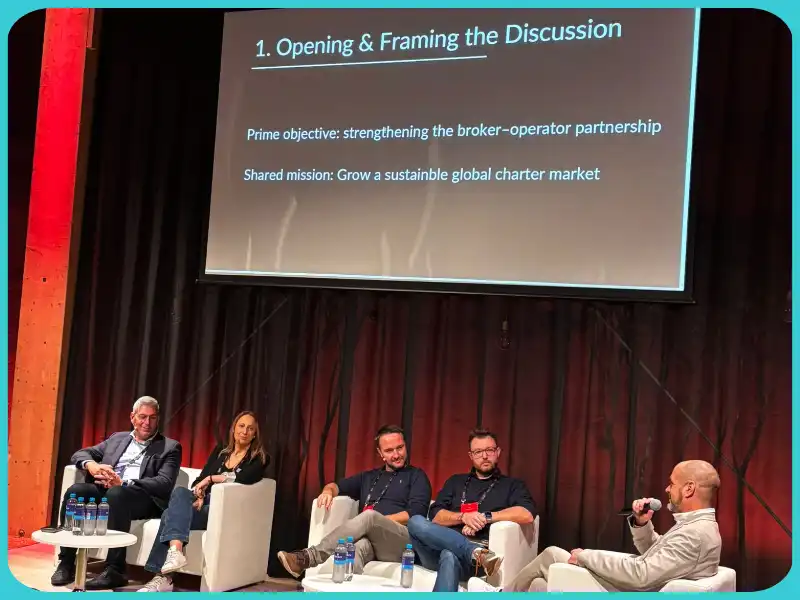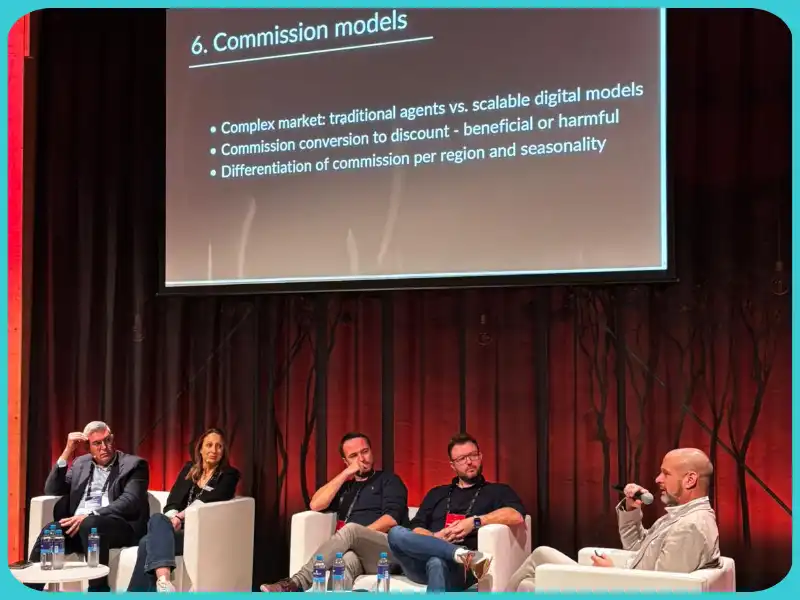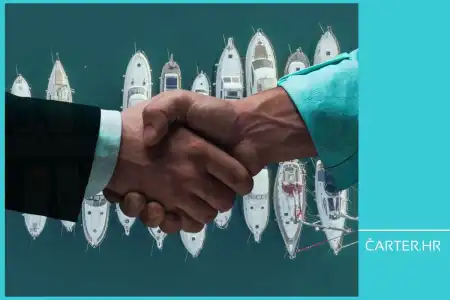
- 15.11.2025.
- News
At the ICE Open Forum in Amsterdam, representatives of charter companies and agents met at the same table. The topic, at least as planned, seemed simple: how to restore profitability and guest satisfaction in sailing. But after the first exchanges, it became clear that the discussion was actually about two issues the industry has been sweeping under the rug for years: who dictates the market and how to steer it toward a more sustainable direction. As the media partner, čarter.hr followed the discussion because we consider it important that charter companies and intermediaries who were not present at the forum clearly hear the messages from both sides.
At the international B2B fair International Charter Expo (ICE) in Amsterdam, on 13 November 2025, the ICE Open Forum was held. A panel featuring representatives of some of the largest yacht charter companies, Luka Šangulin (Angelina Yachtcharter, Croatia), Katerina Goutou (Fyly Yachting, Greece), as well as intermediaries Pavel Pribis (Boataround, OTA platform) and Max Barbera (Barbera Yachting, Germany), moderated by Tino Prosenik.
The forum opened with the presentation of four key topics: the imbalance between supply and demand, the problem of excessive price discounting, different commission models, and real guest satisfaction. Prosenik also explained the structure of the discussion: each topic is introduced, panelists provide their comments, the discussion is opened to the audience, and the segment ends with responses and direct exchange of viewpoints.
This setup immediately suggested that the discussion would address issues shaping the market in recent seasons but rarely discussed publicly. The conversation that followed confirmed this: the industry has reached a moment in which different interests and business models collide, and these four topics reveal both its weak points and potential solutions.
The imbalance between supply and demand opened a discussion about the industry’s sustainability
After introducing the panelists, Prosenik opened the first chapter of the discussion – the imbalance between supply and demand. The topics included: the uncontrolled growth of the fleet driven by yacht sales, the limited pool of customers, the question of who is responsible for expanding that pool, the possibility of developing new service packages, and the challenges brought by digital platforms with their growing influence on retail prices.
The first to speak on this topic was Luka Šangulin, who, from an operator’s perspective, opened the discussion on what has actually been happening in the Mediterranean in recent years. The fleet is growing faster than demand, creating a wide range of questions – from price sustainability, to product differentiation, to who is ultimately responsible for generating new customers.

A comment from the audience further expanded the discussion: the industry will struggle to attract new demand unless it offers greater flexibility and a broader range of services. Experience shows that guests today expect options – different check-in days, shorter stay durations, customised packages, and clear rules applied equally to all market participants. To avoid further declines in utilisation rates and a dependence on discounts, the market must allow guests to more easily find what suits them, and the “rules of the game” must be clearly defined.
This view recurred throughout the entire discussion. The product has become too uniform, too constrained by weekly cycles and too dependent on Saturday check-ins, while at the same time, the industry expects growth in demand that no one is systematically building.
“Young people don’t see sailing. We’re not loud enough.”
A comment from the audience sparked the first major debate: sailing is not suffering from a lack of demand but from a lack of visibility. The speaker pointed out that young people today form their opinions on Instagram and TikTok, yet sailing is almost invisible there. While #sailing has only a few million posts, other types of content reach hundreds of millions. In his words, if a product isn’t visible, it doesn’t exist for the new audience.
He also emphasised that the industry lacks the “media value” created by guests themselves. Globally, around USD 1.5 billion worth of sailing-related content is generated, of which Croatia accounts for about USD 200 million – far too little for serious growth. He sees the solution in actively encouraging guests to share photos and videos, as well as in joint campaigns by operators, brokers, and platforms. “When the volume of content increases, the top of the funnel widens – and so does the market,” he concluded.
Operators: “Pricing is our responsibility. If we lose it, we lose the product.”
Following the discussion about visibility and demand creation, Prosenik steered the panel to the second crucial issue – pricing. He recalled the conclusions from the previous day when representatives of 15 major operators and 15 brokers discussed in a closed session, emphasising that operators are the ones who determine the value of their product and the strategy by which they manage pricing. Although fleet growth has created pressure and triggered phenomena such as price discounting and reliance on promotions, Prosenik stressed that pricing responsibility cannot be handed over to others, nor can one expect all markets to function the same way.
He then asked operators if they agreed that boat prices can't be the same in every country and that the discount strategy must reflect each destination's characteristics, costs, and demand dynamics. At this point, the discussion opened again – this time around who actually has the right to adjust prices and how far such adjustments may go.
Operators clearly stated that pricing must remain in their control. Šangulin said that the industry’s mistake was trying to “cover costs by lowering prices,” which has resulted in situations where a boat is sometimes cheaper than it should ever be.
He explained that different regions have different cost structures – from marinas to management fees – so it is logical that the same type of boat costs more in one destination and less in another. The problem arises when a pricing strategy collapses under discount pressure: once a price drops, it is almost impossible to bring it back to a realistic level.
Another recurring message was that once the price drops, guests learn to wait for discounts. If given the real price the following year, they perceive it as a price increase. This is why operators believe the market should protect the “lowest sustainable price” instead of encouraging a race to the bottom.
Commission is not a discount – yet the industry often treats them as the same
One part of the discussion highlighted a long-standing misconception in the industry: commission and discount are not the same thing, even though they are often used as if they were.
Panelists noted that a commission represents compensation for brokerage work, while a discount is a direct intervention in the price of the product. When these two concepts are mixed, chaos follows: the operator no longer knows the real minimum price of their boat, brokers create a “race to the bottom,” and OTA platforms accelerate the decline of displayed prices in the system.
It was also stressed that misusing commission leads to another harmful outcome: a discount provided by a broker or an OTA platform is actually attributed to the operator, while the guest does not know who lowered the price. This erodes trust, and the operator loses control over the perception of their product’s value. The conclusion was clear – commission must remain a tool for cooperation, while discounts must be exclusively controlled by operators, as this is the only way to maintain sustainable pricing.
Brokers: “Our job is to sell the product—not change its price.”
From the brokers’ side, several strong points were made. Max Barbera was very clear and firm, saying that no discount that changes the price of a boat should be possible – not one percent, not five, not fifteen. In his view, the only sustainable model is one in which the operator sets the price, while the broker competes on service quality, not discount depth.
Other panelists confirmed that some distortions in the market stem from competition among brokers, not because operators want discounts. In some cases, an operator can no longer sell their boat even at their direct price because the market has already seen a lower amount via a third party.
It was also pointed out that some segments of the market do not react to price at all – some customers choose based on the brand of the charter company, destination, type of boat, or known service quality. This suggests that the industry prioritizes guests who are price-sensitive over those who prioritize quality.
OTA perspective: “We do not lower the price, we only display what appears in the system.”
Pavel Pribis, representing a major OTA platform, attempted to explain his position: according to him, the platform does not lower prices but simply displays what brokers or operators provide. If a lower price appears somewhere, the system shows it because guests expect transparency.
He added that OTA platforms bring both advantages and limitations. They can easily scale content and reach a wider audience, but it is difficult to maintain communication quality and customer support across different time zones. He also noted that the platform is working on improving support and is still partly “catching up with its own growth.”
However, these explanations did not fully reassure the audience. One operator openly stated that he had ended cooperation with the platform after repeatedly seeing prices online that were never approved by his fleet.
Audience: “We ended the cooperation because we must protect our product.”
One of the most honest moments came when an operator from the audience explained that he stopped collaborating with an OTA platform after several situations in which prices appeared online that were never authorised.
He said that guests began sending screenshots showing non-existent prices, and he realised he could not maintain fleet quality while competing with discounts he had not approved.
“At the end of the day, the guest thinks we’re raising the price or hiding something. We're just trying to stick to our rules,” he said.
“We don’t sell sailing; we sell hospitality.”
Another notable contribution came from an operator in the audience, who explained that the industry has for years convinced itself that it is still a “sport product,” even though reality has long changed.
He explained that more than ten years ago, he began photographing boats, collecting reviews, and building a B2C approach because guests are not skippers – they are tourists. He emphasised that sailing is no longer a “club of closed-off sailors,” but a tourism product that must be presented and promoted as an experience rather than a technical package.
This viewpoint resonated strongly, partly because many feel the same, and partly because it raises questions about the industry’s need for profound transformation.
The bigger picture: time for standards, categories, and a long-term plan
Toward the end of the forum, the audience brought up an issue few dare mention publicly: the industry lacks standards.
There is no categorisation of boats, no clear service levels, no standardised system for photographs or technical condition. In such an environment, the only reference point becomes – price.
One participant warned that without a long-term strategy, the market risks falling under the dominance of a single large platform, as has happened in other industries. Others pointed out that operators still hold the key – without their boats, there are no platforms or brokers.
A realistic presentation of the offer and fast support are key to guest satisfaction
IIn the final part of the panel, Prosenik introduced the topic of guest satisfaction, reminding the audience that brokers had generally agreed the previous day that guests are overall satisfied. But he immediately posed a follow-up question: what is still missing, and where can improvements be made?
Brokers were direct. In their words, the situation is solid but far from perfect. They explained that they work only with fleets that can guarantee a minimum standard – clean boats, functional equipment, and quick response when something goes wrong. “If you showcase a perfect boat at a fair, and the guest arrives to something completely different, that’s simply bad business,” they said. This is why they avoid operators who cannot consistently deliver what they advertise.
The OTA representative added concrete examples. The most common source of dissatisfaction arises when photos do not match reality – guests expect a TV, air conditioning, or certain equipment because they saw it in the listing, and then discover on arrival that it is broken or missing. “It’s like booking a hotel without having any idea what the room looks like,” he said.
Although many destinations, particularly Croatia and Italy, have significantly improved photography and yacht presentation in recent years, the problem remains. A large part of the content is outdated, lacks consistency, and the gap between expectations and reality still creates frustration. OTA platforms are increasingly sending their own photographers, but stress that without operator cooperation, the gap cannot be closed.
The message was unanimous: guest satisfaction today largely depends on “expectation alignment.” If photos, descriptions, and product presentation do not reflect the real state, no price, discount, or marketing campaign can fix the impression.
After discuDiscussing the fleet, pricing, commissions, and visibility, almost everyone agreed on one thing: in an industry that changes from season to season, those who maintain the strongest relationship with guests are the ones who endure in the long run. Everything else – collaboration models, digital channels, discounts, and platforms – are merely tools that can help or harm that relationship.
Finally, as čarter.hr, we want to remain a place where these topics can be heard clearly and without filters. We will continue speaking with people from the industry, seeking explanations where they are missing, and offering concrete guidance wherever we know it can help. If the industry wants a more stable and healthier path forward, discussions like this must not remain exceptions but should become the standard.
Categories of trends
- News
- Sale
- Marketing
- SEO
- Web design
- Social media
- Technology
- Regulations
- Management
- Education
- Finances
- User experience
Newsletter
Sign up for the newsletter and receive the latest trends and tips straight to your inbox





